

11th October
Athens airport, where the first thing is an aquarium of smoke, a thoughtfully placed smoking room where those desperate after the flight can find  solace.
solace.
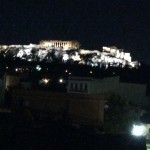 By metro to Thisio, and find the Jason Inn which I picked because you sit on the roof and glory in the Acropolis, all lit in the darkness (it looks splendid at a distance – close up it is entangled by the girders and cranes of perpetual renovation. Supper. (12 euros, tourist menu, including wine).
By metro to Thisio, and find the Jason Inn which I picked because you sit on the roof and glory in the Acropolis, all lit in the darkness (it looks splendid at a distance – close up it is entangled by the girders and cranes of perpetual renovation. Supper. (12 euros, tourist menu, including wine).
12
Breakfast on the roof, and off to the Acropolis, through our nice cheap touristy area, stalls selling ‘handmade jewellery’ etc and a tortoise passes the way (I am at a stage where everything seems mythically significant and this slow wrinkled tortoise is Bob & me tottering up with our sticks). Up & up through green woods.
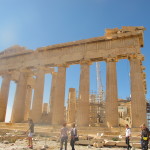
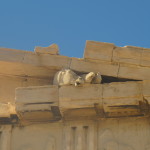 What makes the Parthenon awesome is not just the entasis, the way the columns are convex to make them seem straight and the platform on which they stand slightly concave, to give the whole thing an illusion of perfect regularity, but the way that age has weathered each individually so they are subtly different
What makes the Parthenon awesome is not just the entasis, the way the columns are convex to make them seem straight and the platform on which they stand slightly concave, to give the whole thing an illusion of perfect regularity, but the way that age has weathered each individually so they are subtly different 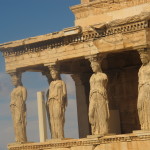 rather than identical – only just noticed this reason for its beauty. Olive tree sacred to Athena.
rather than identical – only just noticed this reason for its beauty. Olive tree sacred to Athena.
So we slip and slide and manage not to fall on the marble and steps, and get to the view, out to Piraeus and sea. But what I love most is the detail of the temples, delicate honeysuckle necklaces round the necks of the capitals of the Erechtheion held up by these maiden caryatids (fake, says B, the real things are in the museum, but they look perfect to me and though fake have weathered well). I keep being reminded of Edinburgh, and Arthur’s Seat and Calton Hill – height after flatness, and the architecture, Doric, Ionic and so forth. The redemption of a city.
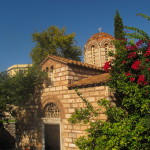 Near hotel is a gem of a Byzantine church, 1065 says the man, medieval, its little domes sprouting like mushrooms, all sunk 3 or 4 feet below today’s pavement level – it’s surrounded by the layered detritus of later ages. Inside, shiny with icons. Young man kneels on floor and rises to kiss an icon which at kissing level is protected by glass, & there are also little copies which you can lift and kiss; it glitters with brass candelabra, silver and gold, and the double headed eagles of old Byzantium. Large eyed saints, gold haloes, browning with age. Main cupola on four pillars.
Near hotel is a gem of a Byzantine church, 1065 says the man, medieval, its little domes sprouting like mushrooms, all sunk 3 or 4 feet below today’s pavement level – it’s surrounded by the layered detritus of later ages. Inside, shiny with icons. Young man kneels on floor and rises to kiss an icon which at kissing level is protected by glass, & there are also little copies which you can lift and kiss; it glitters with brass candelabra, silver and gold, and the double headed eagles of old Byzantium. Large eyed saints, gold haloes, browning with age. Main cupola on four pillars.
Supper again on the roof, I feel amazed B managed to walk all the way there and back, to the Parthenon. Tourist menu again.
13

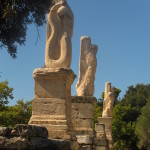 Trains in metro are covered with graffiti. What do they say? Are they rude messages? Or a means of rebellion? Get one of these multi coloured trains to Larisa station to get tomorrow’s tickets, first class! to Thessalonica – and then to the Agora = market place I think, where the Temple of Hephaestus is small and perfect and ornamented with Heracles and Amazons and lapiths and centaurs. I wonder at the beauty of this temple. There are 13 columns along the side, a Fibonacci number, so – it’s a matter in part of perfect proportion. The whole place is full of trees and shrubs, and there are statues of snake deities which once supported a temple (fake says B, as though it matters, because there are some which aren’t, besides, replicas give a chance to see how things were) – and I think of the snake deities of India, chthonic guardians from the earth. Nearby is another little church,
Trains in metro are covered with graffiti. What do they say? Are they rude messages? Or a means of rebellion? Get one of these multi coloured trains to Larisa station to get tomorrow’s tickets, first class! to Thessalonica – and then to the Agora = market place I think, where the Temple of Hephaestus is small and perfect and ornamented with Heracles and Amazons and lapiths and centaurs. I wonder at the beauty of this temple. There are 13 columns along the side, a Fibonacci number, so – it’s a matter in part of perfect proportion. The whole place is full of trees and shrubs, and there are statues of snake deities which once supported a temple (fake says B, as though it matters, because there are some which aren’t, besides, replicas give a chance to see how things were) – and I think of the snake deities of India, chthonic guardians from the earth. Nearby is another little church, 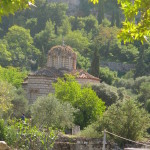 but it’s been renovated and any patina of holiness has been scraped away.
but it’s been renovated and any patina of holiness has been scraped away.
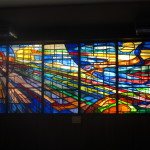 Near hotel is a synagogue, 1930s, open, with stained glass, and a remembrance garden for the Jews who were deported and killed when the Germans invaded, with
Near hotel is a synagogue, 1930s, open, with stained glass, and a remembrance garden for the Jews who were deported and killed when the Germans invaded, with  stones forming a six sided star. (In the 15th century, when the Spanish flung the Moors out of Spain, they also expelled the Jews. Many of these Sephardic Jews made their way to the Ottoman Empire, which had taken over Greece, where they were kept in their proper place but welcomed – this is quite a thought, Muslims taking in Jews kicked out by Christians! Thus in the early 20th century, Thessalonica had a population of l00,000 Jews, reduced by 97% at the end of the war.) (Today, muslims have been evicted to Turkey in a vast population swop, and most old mosques are falling to bits, or turned into museums of ceramics or whatever). The head of the Greek Orthodox Church, Archbishop Samaskinos, was the only head of a European church to demand the Germans stop their persecution (fat lot of good it did).
stones forming a six sided star. (In the 15th century, when the Spanish flung the Moors out of Spain, they also expelled the Jews. Many of these Sephardic Jews made their way to the Ottoman Empire, which had taken over Greece, where they were kept in their proper place but welcomed – this is quite a thought, Muslims taking in Jews kicked out by Christians! Thus in the early 20th century, Thessalonica had a population of l00,000 Jews, reduced by 97% at the end of the war.) (Today, muslims have been evicted to Turkey in a vast population swop, and most old mosques are falling to bits, or turned into museums of ceramics or whatever). The head of the Greek Orthodox Church, Archbishop Samaskinos, was the only head of a European church to demand the Germans stop their persecution (fat lot of good it did).
After lunch go to local hamman. Ladies day. All bit sweaty, but comfortble lying on a marble omphalos beneath a hemisphere studded with stars. Have to wear mini thong & and cover breasts, why so damn modest?
Supper near Monasteraki – people stream by as in a in a parable, in parties, from ships, alone, as lovers, as school children, as tourists – eventually we join this procession of present and ancient ghosts. Girls wear ripped jeans – one sits cradling a brown knee, which at first I think it is a baby.
14
Sit in 1st class waiting room, and when train comes in B asks where is the 1st class compartment. We climb up and B is looking at our tickets, and we try to get past a couple of young men in our way. B squeezes between them, when suddenly Wham! You bloody bastard! B is punching one man in the face, shouting, grabbing his specs and flinging them on the ground, and shouting, and the man drops B’s wallet – fat with euros, diary, credit cards, passport etc. B puts his foot on wallet (pulled from zipped pocket) and retrieves it. Go on our compartment. Phew. Our fellow passengers, a strong young man and a couple, who witnessed the fracas, look the other way, as though we’ve done something embarrassing. I think, this is what it was like for Jews when the Germans rounded them up, people just looked the other way, it was embarrassing and they didn’t want to get involved in any way.
Through craggy mountains with sheep & beehives, & far distant plain; sometimes glimpses of a painting by Claude – the distant sea – an agreeable 5 plus hours to Salonika. The young man and the couple, now friendly, say, of course, those thieves were Rumanians, ie nothing to do with us Greeks, though I’m sure they were Greek – they looked well dressed and educated and not like migrants at all.
Trundle our bags to nearest Hotel Vergina, which is propitious since Vergina is where we are heading. Ask chemist for my cystitis which has suddenly attacked – and bliss, here in Greece they can dish out antibiotics without prescription.
15
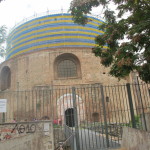 Get bus to city centre – quick, we must get out! There is Alicia’s Arch of Galerius, 4th century! I recognise it from her book. We have a good look,
Get bus to city centre – quick, we must get out! There is Alicia’s Arch of Galerius, 4th century! I recognise it from her book. We have a good look, 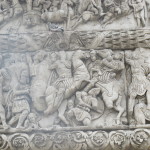 it is a triumphal arch (2nd rate sculptures) by Galerius, one of the Tetrarchs, from when the Roman empire was divided into east and west, about 285 AD. But what I am really impressed by is the adjacent Rotunda, which was built as Galerius’ mausoleum, turned into a church, then mosque, and now being renovated into a church again (?) – it is far larger than the Pantheon in Rome – and although it is being repaired and there are sticks of scaffolding all over the place we can clamber round them and get a glimpse of the wonder that it was, the glittering mosaics, the paintings, & stern compassionate Christ.
it is a triumphal arch (2nd rate sculptures) by Galerius, one of the Tetrarchs, from when the Roman empire was divided into east and west, about 285 AD. But what I am really impressed by is the adjacent Rotunda, which was built as Galerius’ mausoleum, turned into a church, then mosque, and now being renovated into a church again (?) – it is far larger than the Pantheon in Rome – and although it is being repaired and there are sticks of scaffolding all over the place we can clamber round them and get a glimpse of the wonder that it was, the glittering mosaics, the paintings, & stern compassionate Christ.
My pills have upset me so we sit down by Aristotle in his palatial square by the sea. B says pills should be eaten with a meal.
16
We get bus to bus station – splendid new mushroom, much grander than Winchester’s slummy depot – and from there to Verria, modern town on hill slope, in rain. Find decent hotel. In afternoon I get to archeological museum where woman says all today’s parades etc are to celebrate the anniversary of Verria’s freedom from the Turks – this was the last area the last to be freed. Unfortunately there was a lot of rape and a lot of the local people are uncultured and not interested in museums, you can tell by their dark skins she says. This part of Greece only liberated from the Turks after the 1st World War. Museum ok. No one in it.
Nice supper in nearby restaurant, it is Italian which I like because I am sick of feta cheese and stuffed tomatoes & moussaka
17
 Bus to Vergina, which is the point of being here. Here, under a massive tumulus, is the tomb of Philip of Macedon, father of Alexander the Great. It is now a museum, and spooky. He was assassinated at a banquet in his palace nearby,in 336 BC, and so Alexander organised this amazing tomb, and piled it with gold greaves and household goodies. Two other tombs. We walk down a passage into the dark. Here are diadems with gold leaf oak leaves and acorns, and of myrtle, and masks, and the most exquisite diadem with leaves on springs which must have quivered and shook when worn. We are amazed at their sophistication and beauty – I mean, to be so exquisitely made, they must have been />doing this sort of stuff all time time. Paintings, lovely,
Bus to Vergina, which is the point of being here. Here, under a massive tumulus, is the tomb of Philip of Macedon, father of Alexander the Great. It is now a museum, and spooky. He was assassinated at a banquet in his palace nearby,in 336 BC, and so Alexander organised this amazing tomb, and piled it with gold greaves and household goodies. Two other tombs. We walk down a passage into the dark. Here are diadems with gold leaf oak leaves and acorns, and of myrtle, and masks, and the most exquisite diadem with leaves on springs which must have quivered and shook when worn. We are amazed at their sophistication and beauty – I mean, to be so exquisitely made, they must have been />doing this sort of stuff all time time. Paintings, lovely, 
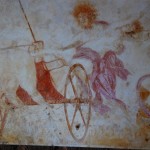 as Pluto
as Pluto 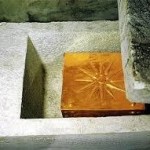 whisks wretched Persephone to the underworld where we stand. But what shocks me is the bones in a gold box of Philip’s latest queen, about 22 years old, obviously burnt in a pyre with his dead
whisks wretched Persephone to the underworld where we stand. But what shocks me is the bones in a gold box of Philip’s latest queen, about 22 years old, obviously burnt in a pyre with his dead  body, favourite dogs etc. I thought the ancient Greeks were too civilized for suti!
body, favourite dogs etc. I thought the ancient Greeks were too civilized for suti!
Come out, from death to life and air.
Lunch at little restaurant full of men watching TV, mixed meze, and wait for bus back to Verria. Vergina is a village built when populations were exchanged, Greeks kicked out of Turkey, Turks out of Greece, for Turkish Greeks. What a tumult it must have been!
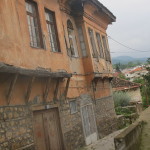 Explore Verria which, away from modern houses, has old buildings with jutting upper floors propped by struts – lots are falling to bits, as are the old
Explore Verria which, away from modern houses, has old buildings with jutting upper floors propped by struts – lots are falling to bits, as are the old 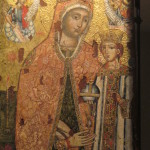 Ottoman mosque and baths and civic buildings. The old synagogue may still be in use (not a clue of what it’s for) but it looks in good nick, and locked. Excellent Byzantine museum – I
Ottoman mosque and baths and civic buildings. The old synagogue may still be in use (not a clue of what it’s for) but it looks in good nick, and locked. Excellent Byzantine museum – I 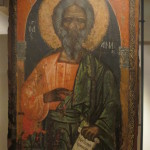 never tire of these forbidding saints gazing from misty gold.
never tire of these forbidding saints gazing from misty gold.
Copyright Sarah Coles 2018 Privacy Policy Website Design & Creation Forum Media and Design - Alresford